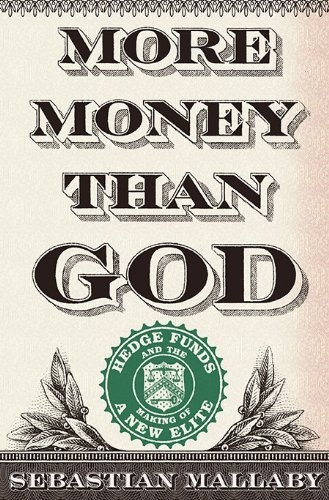More Money Than God: Hedge Funds and the Making of a New Elite by Sebastian Mallaby

1
BIG DADDY
At the dawn of America’s second gilded age, and on the eve of the twenty-
first century’s first financial crash, the managers of a few dozen hedge
funds emerged as the unofficial kings of capitalism. Globalization was
generating unheralded prosperity; and the prosperity was generating deep
pools of wealth; and the wealth was being parked in quiet funds, whose
managers profited mightily. Just in the three years from 2003 to 2006, the
volume of money in the top one hundred hedge funds doubled to $1 trillion
—enough to buy all shares listed on the Shanghai Stock Exchange or an
entire year’s worth of output from the Canadian economy. Nobody doubted
that this hedge-fund phenomenon was new, unprecedented, and symbolic of
the era. “Running a few hundred million dollars for a hedge fund—and
taking tens of millions for yourself—has become the going Wall Street
dream,” one magazine writer declared.
“Hedge funds are the ultimate in
today’s stock market—the logical extension of the current gun-slinging, go-
go cult of success,” according to another.
But hedge funds are not new, and not unprecedented; and whereas the
first line just quoted comes from a New York magazine article published in
2004, the second comes from a remarkably similar essay, also in New York
magazine, published four decades earlier. The 2004 article gushed that
hedge-fund managers are the type who can “call the direction of the market
correctly 22 days in a row.” The 1968 version invoked “the hedge fund guy
who made 20 percent on his money in a week, for seven weeks in a row.”
The 2004 essay complained of hedge funds that “in addition to being
arrogant and insular, they’re also clandestine.” The 1968 version said
peevishly that “most people involved in hedge funds are reluctant to talk
about their success.” If hedge-fund managers had emerged as the It Boys of
the new century—if they had supplanted the leveraged-buyout barons of the
1980s and the dot-com wizards of the 1990s—it was worth remembering
that they were also the hot stars of an earlier era. A hedge-fund manager
“can be away from the market and still know where its rhythm and his are
meshing,” according to a famous account of the 1960s boom. “If you really
know what’s going on, you don’t even have to know what’s going on to know
what’s going on… You can ignore the headlines, because you anticipated
them months ago.”
The largest legend of the first hedge-fund era was Alfred Winslow
Jones, the founding father whom we have encountered already. He was
described in New York magazine’s 1968 essay as the “big daddy” of the
industry, but he was an unlikely Wall Street patriarch; like many of the
hedge-fund titans of a future age, he changed the nature of finance while
standing somewhat aloof from it. In 1949, when Jones invented his “hedged
fund,” the profession of money management was dominated by starchy,
conservative types, known tellingly as “trustees”—their job was merely to
conserve capital, not to seek to grow it. The leading money-management
companies had names like Fidelity and Prudential, and they behaved that
way too: A good trustee was, in the words of the writer John Brooks, “a
model of unassailable probity and sobriety; his white hair neatly but not too
neatly combed; his blue Yankee eyes untwinkling.”
But Jones was cut from
different cloth. By the time he turned his hand to finance, he had
experimented restlessly with multiple careers. He kept the company of
writers and artists, not all of them sober. And although he was to become
the father of hypercapitalist hedge funds, he had spent a good portion of his
youth flirting with Marxism.
Jones was born in the ninth hour of the ninth day of the ninth month of
1900—a fact with which he would bore his family years later.
He was the
son of an expatriate American who ran the Australian operations of General
Electric; according to Jones family lore, they owned the first car in
Australia. A formal photograph from the time shows the three-year-old
Alfred wearing a white sailor cap with a white jacket; on one side of him
sits his father in a stiff, winged collar, on the other side is his mother in an
elaborate feathered hat. After the family returned to GE’s company
headquarters in Schenectady, New York, Alfred went to school there and
followed in the family tradition by attending Harvard. But when he
graduated in 1923, he was at a loss for what to do; none of the obvious
career paths for a gifted scion of the Ivy League appealed to him. The Jazz
More Money Than God: Hedge Funds and the Making of a New Elite by Sebastian Mallaby




